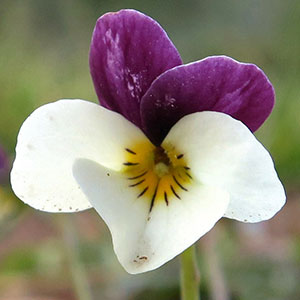Viola hallii
Viola douglasii
Hall's violet, Oregon violet, wild pansy
Douglas' golden violet, Douglas' or Douglas' golden violet, Douglas' violet, Douglas' yellow violet, golden violet
1–3, decumbent or ascending to erect, ca. 1/2 subterranean, glabrous, clustered on single, short, vertical, deep-seated caudex.
1–3, decumbent or ascending to erect, ca. 1/2 subterranean, glabrous or puberulent, from single, short, vertical, deep-seated caudex.
basal and cauline;
basal: 1–4, palmately compound, ± 2-ternate or 3-ternate, leaflets 3;
stipules adnate to petiole, forming 2 linear-lanceolate wings, unlobed, margins entire, apex of each wing free, acute;
petiole 5–8 cm, glabrous;
blade ovate to deltate, 2.8–6 × 2.6–6.5 cm, ± coriaceous, base tapered, ultimate lobes narrowly elliptic, lanceolate, or oblanceolate, 1–7 mm wide, margins entire, ciliate or eciliate, apex acute, mucronulate, surfaces glabrous;
cauline similar to basal except: stipules usually lanceolate, sometimes broadly ovate, ± leaflike, margins toothed;
petiole 1.3–6 cm;
blade 2–4.8 × 1.2–5.5 cm.
basal and cauline;
basal: 1–6, bipinnately compound, leaflets 3–5;
stipules adnate to petiole forming 2 linear-lanceolate wings, unlobed, margins entire, apex of each wing free, acute to acuminate;
petiole 5–6.8 cm, glabrous or puberulent;
blade ovate, 3.5–5 × 2.4–3.5 cm, base tapered, leaflets 3–5-lobed, lobes linear, narrowly elliptic, or oblong, 1–2.5(–5) mm wide, margins entire, usually densely ciliate, apex acute to obtuse, mucronulate, surfaces glabrous or puberulent;
cauline similar to basal except: stipules ovate to linear-lanceolate, margins entire or toothed, apex acute;
petiole 0.9–4 cm;
blade 1.1–4.1 × 1–3.6 cm.
2.5–11 cm, glabrous.
2–12.5 cm, glabrous or puberulent.
sepals lanceolate to ovate, margins ciliate, auricles 0.5–1 mm;
petals: upper 2 almost black abaxially, dark reddish violet adaxially, lower 3 pale yellow, cream, or ± white, lateral 2 bearded, with deep yellow to orange patch basally, dark reddish violet-veined, lowest with deep yellow to orange patch basally, dark reddish violet-veined, 5–18 mm, spur yellow, gibbous, 0.5–2 mm;
style head bearded; cleistogamous flowers absent.
sepals lanceolate, margins ciliate, auricles 0.5–1.5 mm;
petals light golden yellow adaxially, upper 2 dark brown to ± black abaxially, lower 3 dark brown-veined, lateral 2 bearded, lowest 8–21 mm, spur dark greenish to dark brown, gibbous, 1.5–2 mm;
style head bearded; cleistogamous flowers absent.
ellipsoid, 4–12 mm, glabrous.
spherical to oblong, 5–12 mm, glabrous.
light brown, shiny, 3.2–3.5 mm.
light brown, 2.8–3.3 mm.
= 60, 72.
= 24, 48.
Viola hallii
Viola douglasii
Viola hallii was discovered on the grounds of Willamette University in Salem, Oregon, by Elihu Hall, a professor at that institution (V. B. Baird 1942). Leaves of V. hallii are similar to V. beckwithii.
(Discussion copyrighted by Flora of North America; reprinted with permission.)
Viola douglasii is tetraploid (n = 12) south of, and octoploid (n = 24) north of, San Francisco Bay, California. It forms sterile hybrids with V. quercetorum (J. Clausen 1964). V. B. Baird (1936) described V. douglasii × purpurea, which Clausen later said was actually V. quercetorum, not described at the time of Baird’s publication.
(Discussion copyrighted by Flora of North America; reprinted with permission.)


